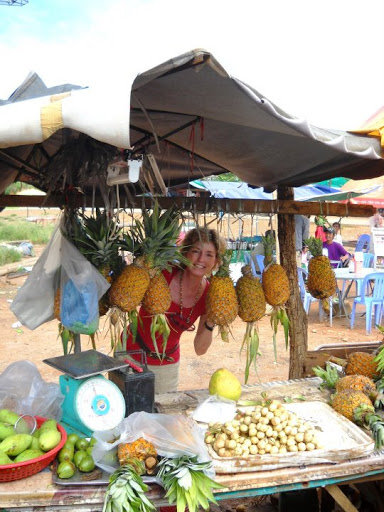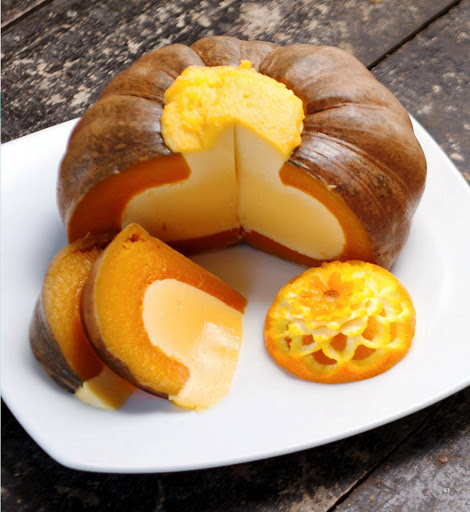I never would have expected there’d be so many adventures involved in writing a cookbook. But this wasn’t just any cookbook. It was a cookbook of traditional Cambodian desserts, where my research took me through the recesses of this country to areas rarely seen by westerners and into the homes and lives of villagers located far off the beaten track.
I squelched through a muddy path in search of a lost village, sat on grass mats with elderly nuns in a mountaintop temple, and scurried past a herd of buffalos in the middle of a rice field. I stood on a remote road waving down cars when our van broke down, talked to villagers in dark, stinky markets, and tasted dishes I’d never heard of.
I also learned this book was about far more than just desserts. It is a portrait of life in Cambodia. The Sweet Tastes of Cambodia paints pictures of tiny villages buried in the remote outskirts of the majestic Angkor Wat temples, and dusty backroads close to the Thai border where no word of English is spoken. It chronicles stories and profiles of people who make up the fabric of this country, and gives a glimpse into corners that are rarely seen by the outside world.

I was hired by Pour Un Sourire d’Enfant (PSE), an NGO which provides education and safety for children scavenging off garbage dumps, to write The Sweet Tastes of Cambodia as a fundraiser for their cooking school. The intent was to document traditional dessert recipes from various regions of the country as well as paint a picture of the cooks, the villages, the legends and the countryside.
Along with an Italian woman (Sveva), a French man (Alexis), an American photographer (Vincent), a Cambodian chef (Savuth), a Cambodian PSE manager (Rithy), and a Cambodian driver, I spent five weeks traversing the country in a minivan, exploring the origins and ingredients of desserts after spending four weeks in the PSE kitchen cooking and documenting the recipes.

Dessert in Cambodia, I learned, is not the same as in the west. It’s not usually served after a meal or in the evening and is often eaten mid-morning while women shop for groceries in local village markets. Ingredients include items our western palate wouldn’t consider dessert, such as cassava, mung beans, and lotus seeds, and many of them are covered in coconut cream, palm syrup, and/or condensed milk.
In the local open-air markets, dessert ingredients are displayed in large silver bowls on stone counters and patrons point to their desired items which are scooped into a bowl, served over crushed ice, and covered in sweet toppings. Sweet snacks include donut balls with sweet lentil filling and icing sugar coatings and waffles made with coconut milk cooked over an open grill. And everyone indulges in the luscious plentiful fruit such as mangoes, rambutan, durian, and the quintessential banana.

The Sweet Tastes of Cambodia takes readers from the bustling capital of Phnom Penh through the lush countryside of this Southeast Asian country. It meanders through the outermost provinces of Ratanakiri and Pailin, and into rustic homesteads where women rise at 4am to mix enormous pans of maple syrup and grind their own flour. In the book, you’ll read about a small island that produces the country’s best pomelos, Cambodia’s only grape winery, and a grandmother who won awards for her ansom chek.
You’ll also get tips from PSE chefs, learn about the legends of the Kratie pagoda, and read about the last living member of the Kola tribe in Pailin. And while not all readers may be able to cut down their own bamboo tree, stuff it with sticky rice and coconut milk, and grill it over an open fire, everyone will be able to appreciate the histories, lifestyles and legends that go into creating desserts such as these.
It is presently only available at Lotus Blanc (the restaurant run by PSE in Phnom Penh) and will soon be in bookshops, hotels, and restaurants around the city.

Photo courtesy and copyright Vincent McNeill
Sang Khja Lapov (Pumpkin Custard)
Ingredients
1 small pumpkin (about ½ kg)
5 egg yolks
45 g palm sugar (or white sugar)
Pinch salt
75g coconut cream
Prep time: 20 mins
Total time: 1 1/4 hours
Serves 4 - 6
1. Wash and peel the pumpkin. Slice off the top and clean out the inside with a spoon.
2. In a small bowl, whisk the egg yolks with sugar and salt.
3. Add the coconut cream to the mixture.
4. Pour the custard mixture inside pumpkin shell almost it almost reaches the top
5. Steam the pumpkin for 40 – 50 minutes until it becomes soft. The custard is set when it doesn’t jiggle when it is shaken and when a knife inserted into the center comes out clean. The custard should not be fluid and should be firm enough to stand on its own.
6. Cool the pumpkin.
7. To serve, slice through the skin and cut the pumpkin into wedges, taking care not to dislodge the custard inside the shell.
8. Serve cold.
COOK’S NOTE: Instead of pumpkin, any winter squash such as butternut squash or acorn squash works just as well. The older looking the pumpkin the better it will taste. Another way to spot a good pumpkin is to look for a stem that looks like cork.
Gabrielle Yetter is a published writer who started her career as a journalist on The Star newspaper in South Africa. She has worked in the US and UK and is now living in Cambodia, where she volunteers for an NGO and works as a freelance writer. Her work has been published in Southeast Asia Globe, AsiaLife, Latitudes, Khmer440, Expat Advisory, and Mighty Mercury and she recently completed a book about traditional desserts in Cambodia (" The Sweet Tastes of Cambodia") which was published in December 2012, and is the author of our upcoming book, Moving to Southeast Asia: Cambodia. She has lived in India, Bahrain, England, and the U.S. and loves to explore the world and eat cupcakes (not necessarily in that order). Find her online at http://www.gabrielleyetter.com/
All photos courtesy and copyright Gabrielle Yetter, except where noted
